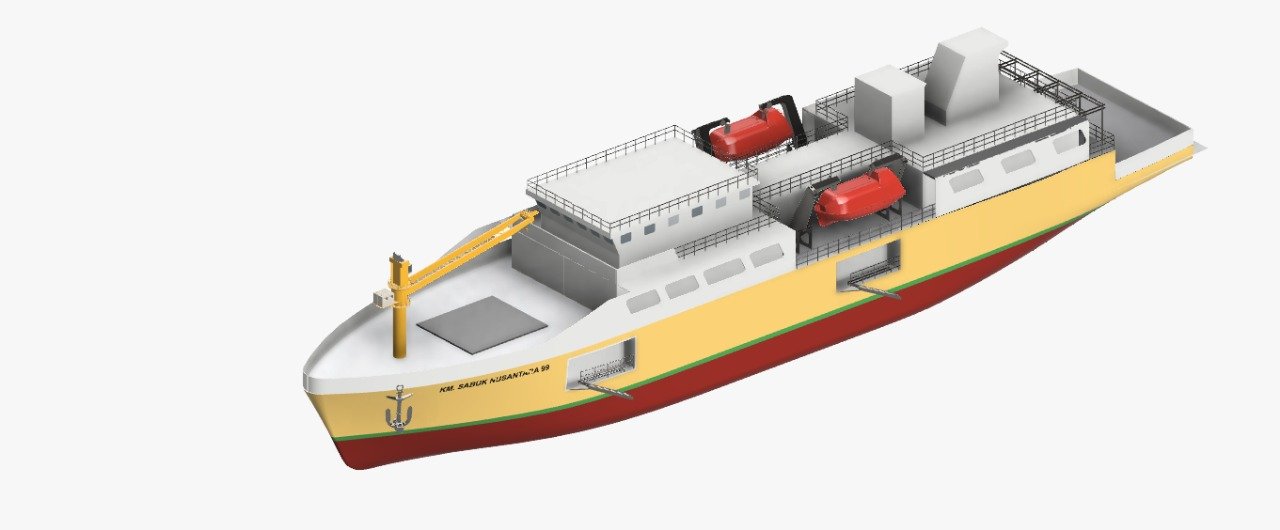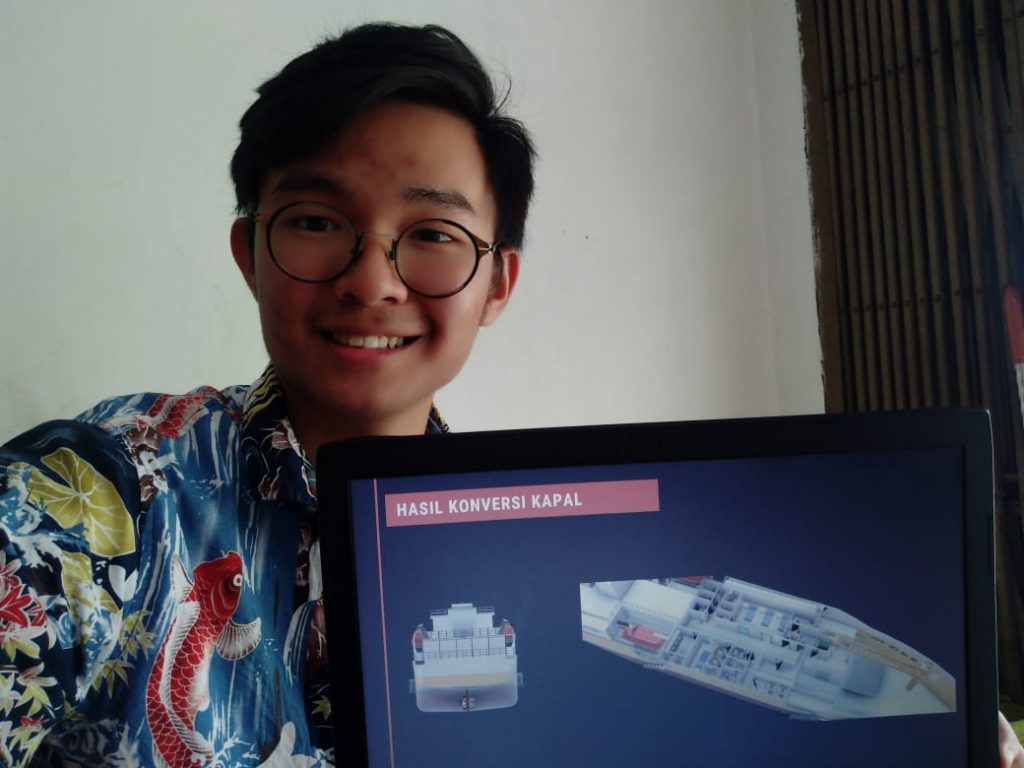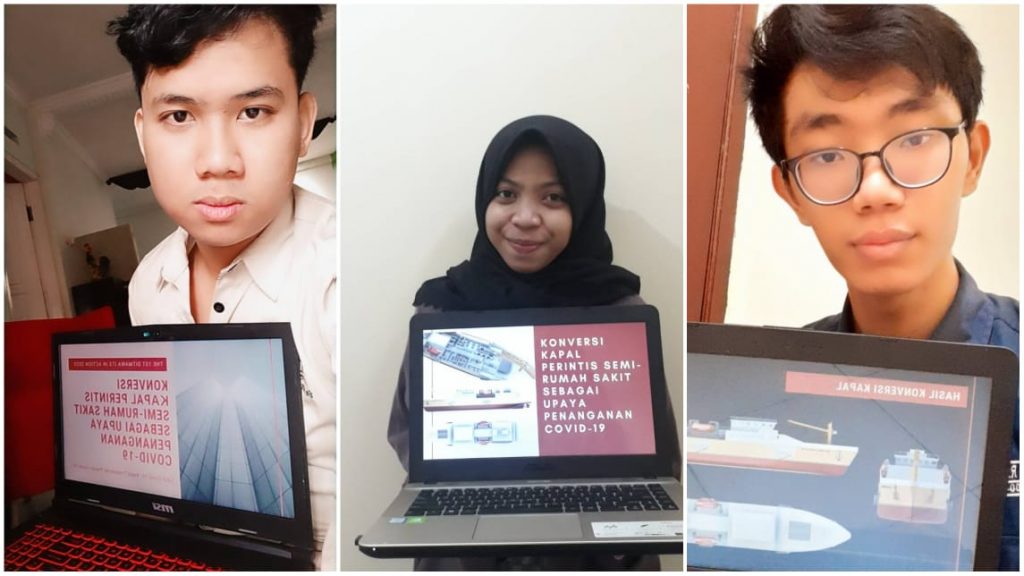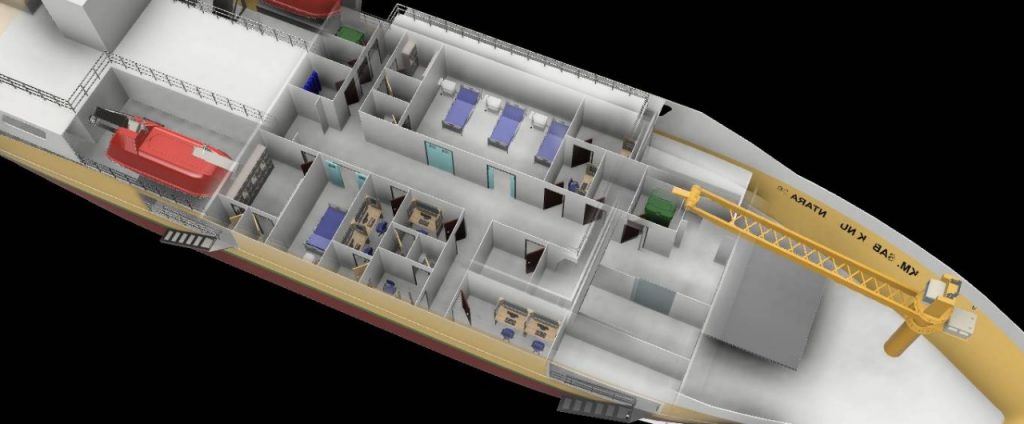Accommodates the Handling of COVID-19 Patients, ITS Students Convert a Pioneering Semi-Hospital Ship

Prototype conversion of a pioneering semi-hospital ship constructed by a team of ITS students
ITS Campus, ITS News – Served as an aid to overcome the COVID-19 pandemic in Indonesia, four students from the Department of Naval Architecture and Shipbuilding Engineering of Institut Teknologi Sepuluh Nopember (ITS), who belonged to the Doa Ibu Team, successfully innovated a transporter ship for medical services. This innovation was rewarded with the highest achievement in the COVID-19 Innovative and Inspirational Application Competition (Lomba Aplikasi Inovatif dan Inspiratif Covid-19), crowned champion in the sub-competition of Transporter Ships.
They were Michael Wei, Haritz Azzarie, Novi Anggia, and Fadilla Rafiansyah Anwar, who initiated the idea of converting the pioneering semi-hospital ship. This innovation was a new conversion design of a pioneer ship named KM Sabuk Nusantara 99. “This pioneering ship was chosen because the owner requirements are considered the most appropriate for conversion,” stated Michael Wei, as the leader of the Doa Ibu Team.
Michael revealed that the idea was lifted from the lack of facilities to handle the COVID-19 patients and the several vessels functioning as hospitals that existed. On the basis of the two aspects, the idea of converting a pioneer ship equipped with medical facilities appeared. “The conversion of the ship is aimed to streamline the production time of shipbuilding in large numbers because the management of COVID-19 must be done quickly,” he added.

Doa Ibu Team Leader, Michael Wei, when demonstrating the prototype conversion of the pioneering ship made by his team
According to Michael, the conversion of the ship was not completely carried out on the parts of the ship. The conversion design plan applied utilized the concept of alteration_, whereas the conversion on the ship would not affect the characters of the ship that was to be converted. “Thus, the ship we converted still has the old functions, either as a passenger or a logistic transporter ship,” he identified.
Elaborated further on conversion, Michael mentioned that the conversion was only applied on a portion of the main deck while the crew deck that was transformed into a treatment facility for COVID-19 patients. As for the main deck, the converted part was located at a portion of the passenger area, which was approximately 236 cubic meters. This was used as a medical treatment facility starting from the patient’s room, medical waste treatment, oxygen room, nurses’ and doctors’ bedroom, as well as other needs related to handling COVID-19. As for the crew deck, the first classroom is converted into embarkation access.

(from left to right) Members of the Doa Ibu Team, namely Haritz Azzarie, Novi Anggia, and Fadilla Rafiansyah Anwar, when showing prototypes of the hospital ship conversion for COVID-19 patients
In addition, Michael added that there was another innovation implemented, which was the partitioning of COVID-19 control rooms to minimize the contamination risk of other rooms in the pioneer ship. Hand-in-hand with the application of Negative Room Pressure, which is integrated also with High-Efficiency Particulate Air (HEPA) medical standard filters, was intended to ensure that other rooms in the ship will be in very safe conditions. “Our ship is also designed to have a box crane served to transport COVID-19 patients with limitations, such as wheelchair users,” he added.
Michael conveyed that the conversion of pioneering ships with a number of modifications was advantageous because the initially long duration of shipbuilding can be shortened, thus minimizing the costs exerted. This should be implemented while still considering an effective, efficient, and ergonomic design based on several reference designs from hospitals, and also other treatment facilities in the form of land buildings, or buildings on ships. “We excel by calculating aspects of the construction time, while others simply design ships with existing owner requirements without considering other aspects,” he expressed.
 The design of the pioneering semi-hospital conversion ship innovated by the ITS Doa Ibu Team to handle COVID-19 patients
The design of the pioneering semi-hospital conversion ship innovated by the ITS Doa Ibu Team to handle COVID-19 patients
In the process of its construction, the Doa Ibu Team only took two months. During that period, the work allocation consists of ship modeling, technical calculations, and ventilation installation on the ship guided by an ITS Naval Architecture and Shipbuilding Engineering lecturer, namely Dr. Eng. Yuda Apri Hermawan, S.T., M.T.
When asked about the obstacles faced, this student born in Batam explained that the biggest challenge experienced by the team was distance, considering that the four members came from different regions. “At times when communication and discussion about this competition are needed, we were a little constrained due to the lack of medium for discussion on top of the difficulty in scheduling due to different areas of origin and availability of each member,” he explained.
In the end, this student of batch 2017 hoped that the conversion of his pioneering ship can be further refined with other innovative designs that can be applied and equipped to his team’s transporter ship. “This competition is a stepping stone for me and the team as students, especially in the maritime field, to be able to work even better in a pandemic situation like this,” he concluded. (bob/ory/ITS Public Relations)
Related News
-
The Indonesian Minister of Creative Economy Visits GRIT ITS to Review Creative Economy Development
ITS Campus, ITS News — The Sepuluh Nopember Institute of Technology (ITS) continues to demonstrate its commitment to bridging research and innovation,
August 03, 2020 23:08 -
AHY Ignites ITS Freshmen’s Spirit to Achieve Golden Indonesia 2045
ITS Campus, ITS News — Greeted with thunderous enthusiasm, the Coordinating Minister for Infrastructure and Regional Development of the Republic
August 03, 2020 23:08 -
Starting the New Academic Year, ITS Inaugurates 6,993 New Students
ITS Campus, ITS News — Kicking off the 2025/2026 academic year, the Sepuluh Nopember Institute of Technology (ITS) officially inaugurated 6,993 new undergraduate
August 03, 2020 23:08 -
Fira, a frequent student at ITS, is the youngest at 15 years old
ITS Campus, ITS News — At the 2025 New Student Inauguration (PMB) ceremony at the Sepuluh Nopember Institute of Technology (ITS),
August 03, 2020 23:08
